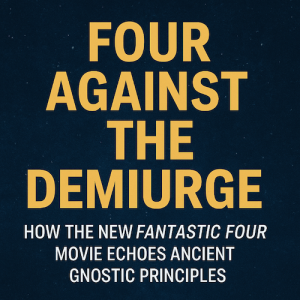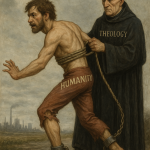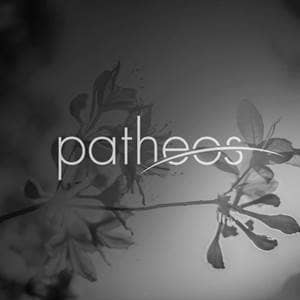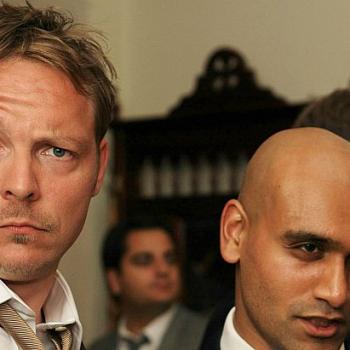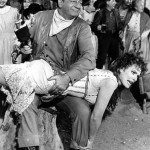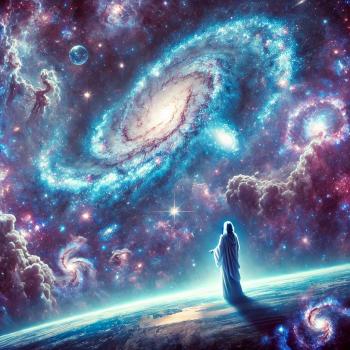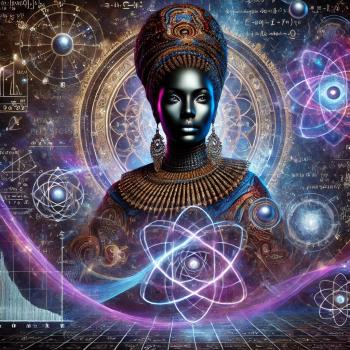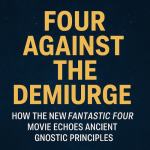�️ Gnostic Cinema Has Entered the Chat
Just watched the latest reboot of Marvel Studios, “The Fantastic Four: First Steps.” As a Fantastic Four fan since childhood, I anxiously awaited the release of this movie. Marvel called it, “The World’s Greatest Comic Magazine,” and I wholeheartedly agree. Having traveled through the religious multiverse through the vessel of Christianity for much of my life – and having changed ships into agnostic antitheism with heavy gnostic seasoning, I viewed this rendition of the Fantastic Four through a different but exciting lens.
For the record, Aaron Tomlinson and I discussed this in the latest episode of “The Gnostic Agnostics.”
The Marvel Cinematic Universe has officially gone metaphysical!
As timelines unravel and sacred geometry becomes plot device, superhero storytelling is starting to echo something ancient—something esoteric, mystical, and deeply spiritual. Something Gnostic.
And Marvel’s Fantastic Four reboot? It’s not just superhero origin—it’s cosmic initiation.
This is a mythic tale about divine sparks trapped in flawed bodies, false gods feeding on creation, and a spiritual awakening that begins with trauma and ends in transcendent clarity.
With the inclusion of Galactus, Shalla-Bal (the Silver Surfer reimagined as a feminine archetype), Victor Von Doom, and Franklin Richards, the film boldly steps into a Gnostic mythos—and dares to make meaning where other blockbusters settle for explosions.
� Gnosticism 101: The Map Behind the Movie
To understand what’s really going on, we need to talk Gnostic cosmology.
In Gnostic thought:
- The material world is not divine. It’s a flawed simulation.
- A false god, the Demiurge, created it, mistaking itself for the Source.
- A higher reality—the Pleroma—exists beyond, radiating light and unity.
- Inside every human is a divine spark (pneuma), buried under matter (hylic flesh).
- Salvation doesn’t come through obedience—it comes through gnosis: deep, intuitive, experiential knowing.
The Fantastic Four isn’t just a team. They’re a metaphor for the parts of the soul, torn by illusion and finally made whole.
� Four Who Fell—And Rose
Each of the Four embodies a path through the Gnostic labyrinth. They are not superheroes—they are archetypal energies undergoing awakening.
� Johnny Storm – The Divine Spark (Pneuma)
Johnny, the Human Torch, doesn’t just light up—he burns. He embodies the divine spark (pneuma) trying to break free of containment.
His fire is raw and reactive at first—flaring with ego, youth, and bravado. But throughout the film, we watch Johnny’s spark evolve from chaotic flame to illuminating presence.
He learns to become light without destruction. He moves from recklessness to radiance, from heat to clarity. Johnny’s arc is the spiritual awakening of energy itself—untamed fire refined by purpose.
� Ben Grimm – The Imprisoned Soul (Hylic Flesh)
Ben becomes The Thing—a body made of stone. He is the embodiment of material entrapment, the soul trapped in matter, the hylic self. He never asked for his mutation, just as Gnostic souls never asked to be thrown into the flawed world.
His transformation is a metaphor for the trauma of incarnation.
But Ben is not just tragic—he’s deeply human. His path is about reconciling strength and sensitivity. He is the hylic shell that learns to feel again. His spiritual arc is not one of escape, but of dignity. He finds his spark not by shedding the stone—but by loving what lives inside it.
� Reed Richards – The Overreach of Intellect (Nous)
Reed, aka Mr. Fantastic, stretches his body infinitely—but it’s his mind that reaches too far. He is the Gnostic nous—the rational intellect that tries to systematize the cosmos.
In Reed, we see both the potential and the peril of intellect. He believes knowledge can save everyone. But knowledge without wisdom becomes control.
Reed’s awakening comes when he lets go of the illusion that everything must make sense. He learns to trust the unknown, to surrender to the mystery. Only then does he stop stretching toward God and start embodying gnosis.
� Sue Storm – Sophia, the Hidden Force Who Leads
And then there is Sue Storm, the Invisible Woman, the beating heart of this myth.
In Gnostic thought, Sophia (Greek for Wisdom) is the divine feminine exiled from the Pleroma. She gives birth to the Demiurge through an act of solitary creation and is punished for reaching without permission. Sue channels this myth with sublime power.
Her invisibility is not a limitation—it’s a metaphor for how feminine wisdom is hidden, dismissed, and underestimated.
But Sue is not just a mother, not just a sister, not just “Reed’s wife.” She is a strategist, a diplomat, and the emotional glue of the team.
She negotiates with enemies. She builds consensus within the team. She protects through force fields and through presence. And when the world faces annihilation, she leads.
Sue doesn’t need validation. She is the validation—the presence that transforms fear into fortitude. In her, Sophia rises—not as a victim, but as a visionary.
�️ The Quantum Realm – The Kenoma
Their transformation occurs in the Quantum Realm, a dimension of entropy and paradox.
In Gnostic terms, this is Kenoma—the Void. It’s the holographic false world beneath the real world. The Quantum Realm mimics the Pleroma, but lacks truth. It changes those who enter. It wounds before it awakens.
From this realm, the Four emerge not merely as altered beings—but as initiated souls.
� Shalla-Bal – Herald of Hunger, Avatar of Light
In this version of the myth, Galactus’s herald is not the Silver Surfer, but Shalla-Bal—a reimagined feminine archetype of the Logos in exile.
Shalla-Bal is radiant and tragic. Her silver skin reflects light, but she herself is chained to a hunger she does not understand. She traverses galaxies to prepare worlds for death—but inside her, something resists.
Like Sophia, she remembers what she forgot. Through her encounter with Sue—a meeting of exiled wisdoms—she awakens. Sue doesn’t defeat her; she sees her. And in that act of seeing, Shalla-Bal begins to reclaim her identity.
She stops being a herald of death and becomes a witness to the real.
She breaks the cycle by remembering the light she was forced to reflect.
� Galactus – The Devouring Demiurge
Galactus is not a villain. He is a false god—the embodiment of the Demiurge.
He believes himself to be necessary. He devours planets not out of hatred, but as a function of his existence. He is entropy dressed in cosmic robes. He says he brings balance, but in truth, he enforces obedience.
Galactus doesn’t see himself as wrong—he sees himself as inevitable.
And that is what makes him dangerous.
In Gnostic myth, the Demiurge is blind. He creates worlds thinking himself divine. Galactus is this blindness personified—so large that he cannot see his own absence of light.
� Victor Von Doom – The Archon Masquerading as God
Then there is Victor Von Doom.
(Spoiler alert: Von Doom’s presence in the film is limited but he’s an essential part of the Fantastic Four Arc, so I explicate his character here)
He is not just a rival to Reed. He is an Archon—a shadow of the divine pretending to be the real thing.
Doom mimics godhood. He wears the trappings of sovereignty. But underneath the armor is insecurity, fear, and hunger.
He doesn’t want to defeat the Fantastic Four — he wants the respect and adoration they enjoy.
Doom’s path is the dark mirror of gnosis: control instead of curiosity, dominance instead of awakening. Where Sue leads by consensus, Doom rules by force. Where Reed stretches to understand, Doom stretches to command.
In Gnostic terms, Doom is not just evil. He is deluded. And delusion, left unchecked, always becomes tyranny.
� Franklin Richards – The Aeon of the New
Franklin Richards, the child of Reed and Sue, is not a subplot—he is the future of the myth.
In the comics, Franklin creates universes. But symbolically, he is the Aeon—the product of Nous and Sophia, of intellect and wisdom rejoined.
He is not just powerful. He is whole.
And that’s why Galactus fears him—and Doom wants him.
Franklin doesn’t fight. He remembers. He doesn’t destroy. He creates. He doesn’t serve anyone. He reveals everyone.
He is the next age of gnosis.
⚔️ How They Win: Gnosis Over Firepower
The Four don’t defeat Galactus with weapons. They don’t destroy Doom with fists. They win through awareness.
Reed relinquishes control.
Ben accepts the beauty of his strength.
Johnny refines his fire.
Sue leads, protects, negotiates, and commands.
That truth—spoken not with fear, but with knowing—ends the illusion.
Galactus, unmasked, retreats.
Doom, exposed, collapses.
Shalla-Bal, freed, rises.
✨ The Gnostic Gospel According to Marvel
This film isn’t just about heroes.
It’s about initiation.
The Four are no longer test subjects. They are souls who remember. Shalla-Bal becomes not a herald of destruction, but a carrier of gnosis. Franklin is not the messiah—but the message.
And Sue Storm, no longer just a support role, emerges as the spiritual anchor of the entire cosmology.
� Wrapping it Up…
You are not flesh alone.
You are fire, mind, protection, wisdom, and unbreakable love.
You are not here to obey.
You are here to remember.
The Demiurge may devour. The Archons may posture.
But the spark is still in you.
Faith is optional.
Curiosity is canon. And Gnosticism is “A Better Way to Christian.”
Have you seen “Fantastic Four: First Steps” yet? What did you see in the characters and the plot? What are your thoughts? I’d love to hear what you think; hit me up in the comments below!
Derrick Day is the author of Deconstructing Religion, Deconstructing Religion 2, The Martial Leader, MetaSpeech, and the host of The Forward Podcast.
Follow him on Facebook, Instagram, TikTok, and YouTube


